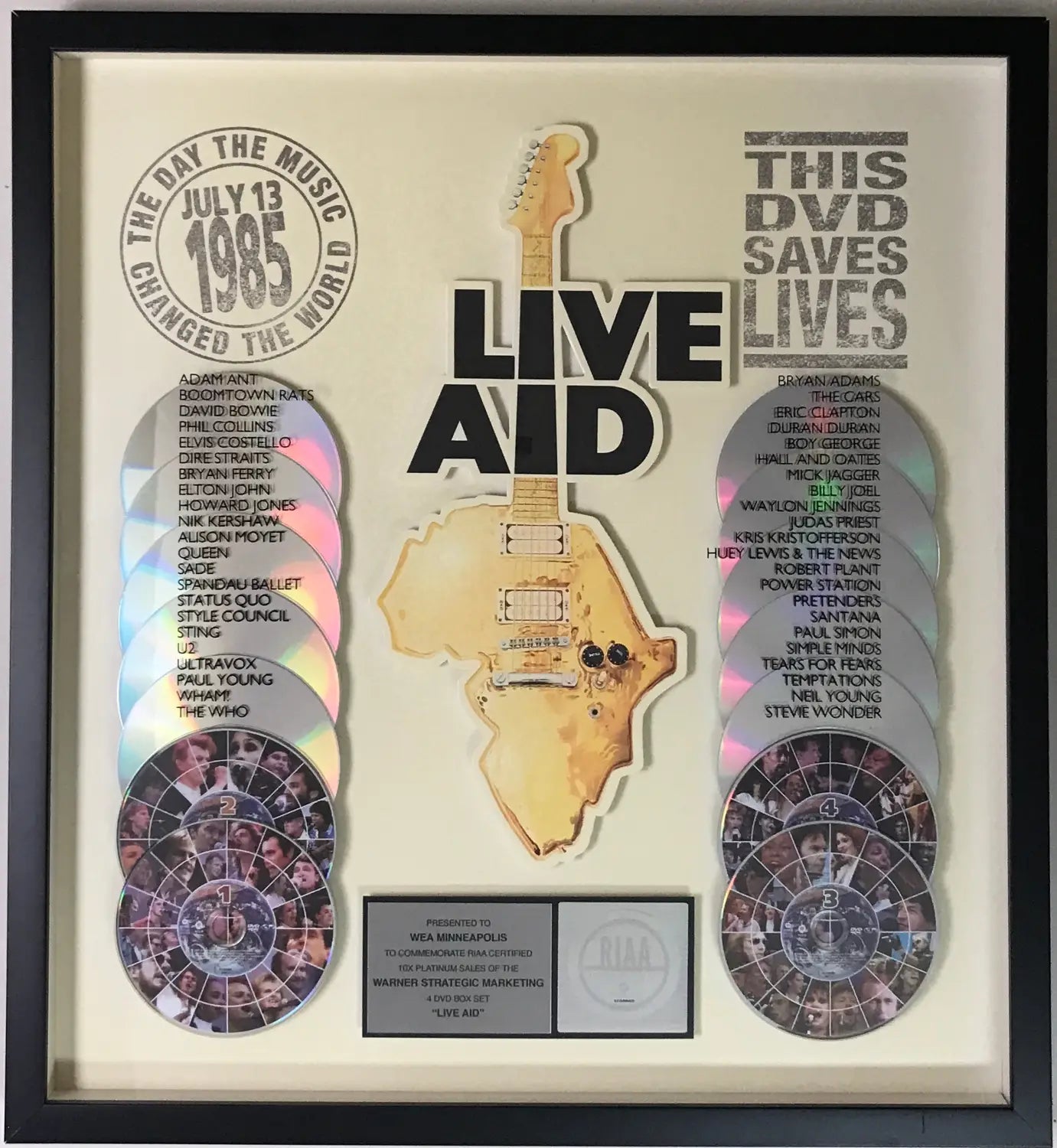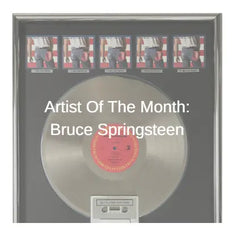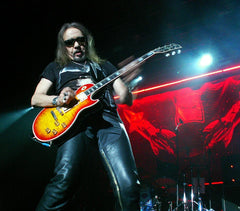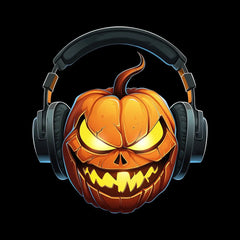Can you believe it’s been 40 years since Live Aid? On July 13, 1985, the world witnessed a global jukebox like no other. Broadcast to nearly two billion people across 150 countries, this monumental charity concert didn’t just change music history — it tried to change the world.
Now, four decades later, we’re still recalling with awe Queen’s electrifying set and marveling at how rock stars briefly became superheroes.
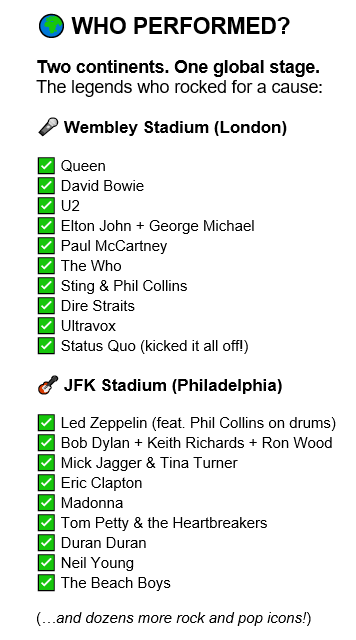
The Day The World Tuned In
Back in the mid-80s, famine ravaged Ethiopia. BBC’s Michael Buerk aired haunting footage of starving children, jolting the globe awake. Among those deeply moved was Bob Geldof, frontman of The Boomtown Rats, who decided to do something more powerful than just rage against the machine.
After organizing the hit charity single “Do They Know It’s Christmas?” with Ultravox's Midge Ure in 1984, Geldof dreamed bigger: a massive concert that would reach around the planet.
Thus, Live Aid was born — an audacious, transatlantic mega-show with one simple goal: raise money to help those who desperately needed it. And boy, did they pull it off.
Two Stadiums, One Cause
The magic of Live Aid unfolded across two main stages: Wembley Stadium in London, and John F. Kennedy Stadium in Philadelphia. For 16 hours, a revolving door of the biggest stars on Earth took turns rocking out under the scorching sun (and on millions of TV screens).
At Wembley, Prince Charles and Princess Diana kicked things off, waving to the 72,000-strong crowd. Meanwhile, across the Atlantic, another 100,000 people gathered in Philly, baking under July’s relentless heat.
Satellite hookups beamed acts from other parts of the world, making it a truly global festival. Never before had live music connected humanity on such a scale. Even today’s endless YouTube streams can’t replicate that magic moment of communal watching.
The Stars Who Lit Up The Stage
Let’s get to the fun part: the legendary performances... and we have to mention that an extensive list of great artists gave their time to perform at this event. The list above is only a taste of those present. For a complete list of artists who performed--along with the songs they played--see the list at the bottom of this article.
Some highlights from Wembley Stadium in London:
Queen’s 20-minute set at Wembley is often hailed as the greatest live performance in rock history. Freddie Mercury, in his iconic white tank top, had 72,000 people clapping in perfect unison during “Radio Ga Ga.” When he belted out “Bohemian Rhapsody” and “We Are the Champions,” it was less a concert and more a shared global anthem. Fun fact: Their set was so electrifying that many bands watching backstage realized they’d just been upstaged for eternity.
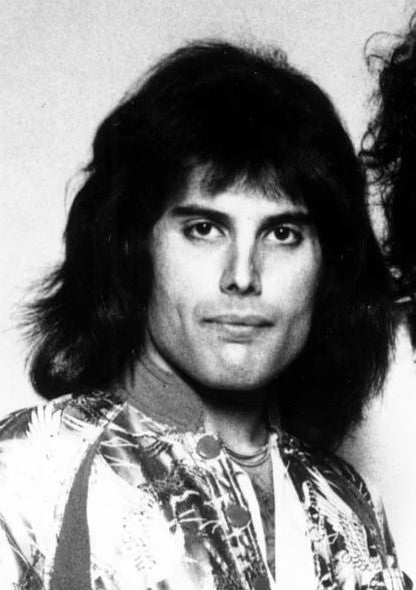
U2, then still climbing toward superstardom, stretched “Bad” into a 12-minute epic, with Bono jumping off stage to dance with a fan, cementing their reputation as stadium legends.
David Bowie performed “Heroes,” sending chills down millions of spines after his 18-month hiatus from touring.
Dire Straits rolled through "Sultans Of Swing" and "Money For Nothing", the latter featuring an appearance by Sting for his well-known vocal cameo.
Paul McCartney was joined by Alison Moyet, David Bowie, Bob Geldof, and Pete Townshend (who tried tickle McCartney mid-performance) for a bluesy rendition of "Let It Be".
Elton John brought out George Michael for a soulful duet on “Don’t Let the Sun Go Down on Me,” a collaboration that decades later still gives goosebumps.
Meanwhile, over in Philly:
Led Zeppelin reunited (sort of — with Phil Collins on drums).
Mick Jagger and Tina Turner gave a sizzling, borderline scandalous rendition of “State of Shock,” with Jagger famously tearing off Tina’s skirt mid-song.
Madonna treated the crowd to several of her pop anthems that were then ruling the airwaves and also a joint performance with Thompson Twins and Nile Rodgers.
Eric Clapton stirred the crowd with "Layla", "She’s Waiting" and "White Room", also with Collins on drums.
The Cars delivered their brand of peak New Wave with a set that included "You Might Think," "Drive," "Just What I Needed" and "Heartbeat City."
Bob Dylan, Keith Richards, and Ron Wood closed out Philadelphia’s show with a ramshackle acoustic set that, while musically messy, perfectly embodied rock’s ragged, spontaneous soul.
Phil Collins was truly one of the real MVPs of the day. After playing some of his solo hits including "In The Air Tonight" at Wembley in London he then hopped on the Concorde to Philly to play drums for both Zeppelin and Eric Clapton. Talk about commitment!

The official Live Aid calendar became a collector's item
Changing The Tune Of Charity Forever
By the time the last guitar chord faded, Live Aid had raised over $125 million (about $350 million today) for famine relief. But its impact was far deeper than numbers.
It revolutionized how we think about celebrity charity. Before Live Aid, star-studded fundraisers weren’t common on this scale. This was the blueprint for everything from Farm Aid to 9/11 telethons to Global Citizen concerts. Suddenly, it was cool — even expected — for rock gods to wield their fame for good.
It also showed the sheer power of live television. The concert was broadcast to every corner of the globe, from New York apartments to African villages with a single shared TV. For many, it was the first time seeing artists like Queen or Bowie perform live. It transformed concerts into global experiences, paving the way for today’s live-streamed festivals.
Not Without Its Critics (and lessons)
Of course, Live Aid wasn’t perfect. Critics later pointed out that some of the money didn’t reach those it was intended to help, due to local corruption or logistical nightmares. Others argued it oversimplified the famine crisis, framing it as a charity issue rather than the result of complex geopolitical problems.
But even those critiques underline how Live Aid sparked serious conversations about aid, accountability, and international responsibility. It wasn’t just about singing songs; it forced millions to confront suffering on the other side of the world, sometimes for the first time.
40 Years Later: Why We Still Remember
So why does Live Aid still loom so large in our collective memory?
Maybe it’s because, for one glorious day, music truly tried to save the world. Rivalries were set aside, egos put on hold (well, mostly), and the spotlight wasn’t just on the stars, but on millions struggling to survive.
It’s also a reminder of music’s unmatched ability to unite us. Whether you were dancing in the aisles at Wembley, sweating in Philly, or glued to your living-room TV, you were part of something bigger than yourself. And judging by the billions of YouTube replays, we still crave that feeling.
Plus, let’s be honest — Freddie Mercury commanding 72,000 people to chant “Ay-Oh” with him will never not be the coolest moment in rock history.
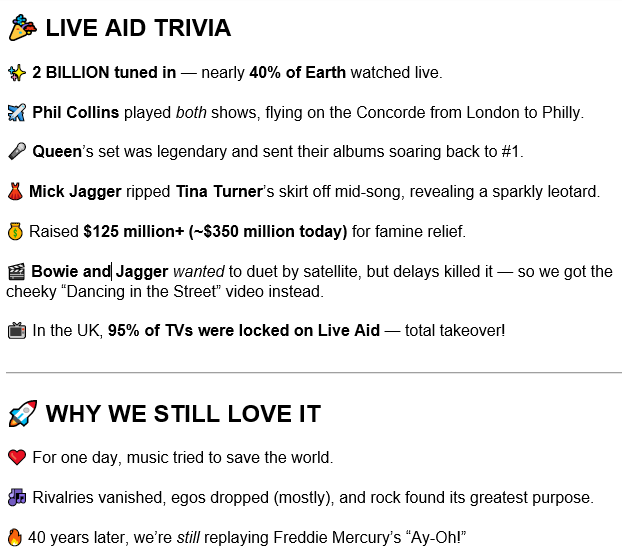
The Legacy Marches On
Today, anniversary tributes and documentaries keep Live Aid alive. Young artists cite it as inspiration for benefit concerts. Fans still swap stories of where they were when their favorite artist hit the stage. And the concert’s ripple effect continues through charities that sprang up in its wake.
Most of all, Live Aid proved that rock ’n’ roll could do more than just entertain — it could shake the world’s conscience. For one sun-soaked Saturday in 1985, it did exactly that.
So here’s to Live Aid at 40: a towering reminder that sometimes, all you need is a microphone, a stage, and a cause worth singing for. Rock on!
Check out a genuine vintage Live Aid calendar here (if still available) or memorabilia items from all sorts of Live Aid performers and 80s artists here.
Interested in genuine, properly authenticated signed music memorabilia? Check out our selection here. How about genuine RIAA Gold and Platinum and other record awards? Check out our selection here. We typically have hundreds in stock.
Want more content like this? If you're not a subscriber already, sign up for our free MusicGoldmine newsletter which comes out every two weeks. Go here to sign up plus get a code for 15% off your first purchase.
Be the envy of all your friends! Get MusicGoldmine.com Music History in your Facebook feed each day. Just follow us on Facebook here
Complete List of Live Aid Performers and Songs:
London, Wembley Stadium
|
12:00 |
Coldstream Guards |
"Royal Salute" |
|
12:01 |
Status Quo |
"Rockin' All Over the World" |
|
12:19 |
The Style Council |
"You're the Best Thing" |
|
12:44 |
The Boomtown Rats |
"I Don't Like Mondays" |
|
13:01 |
Adam Ant |
"Vive Le Rock" |
|
13:17 |
Ultravox |
"Reap the Wild Wind" |
|
13:46 |
Spandau Ballet |
"Only When You Leave" |
|
14:07 |
Elvis Costello |
"All You Need Is Love" |
|
14:22 |
Nik Kershaw |
"Wide Boy" |
|
14:53 |
Sade |
"Why Can't We Live Together" |
|
15:18 |
Sting |
"Roxanne" (Sting) |
|
15:49 |
Howard Jones |
"Hide and Seek" |
|
16:08 |
Bryan Ferry (w/ David Gilmour as backing guitarist) |
"Sensation" |
|
16:40 |
Paul Young |
"Do They Know It's Christmas?" (intro) |
|
17:19 |
U2 |
"Sunday Bloody Sunday" |
|
18:00 |
Dire Straits |
"Money for Nothing" (with Sting) |
|
18:41 |
Queen |
"Bohemian Rhapsody" (ballad segment) |
|
19:23 |
David Bowie |
"TVC 15" |
|
19:59 |
The Who |
"My Generation" |
|
20:50 |
Elton John |
"I'm Still Standing" |
|
21:48 |
Freddie Mercury |
"Is This the World We Created...?" |
|
21:51 |
Paul McCartney |
"Let It Be" |
|
21:57 |
Band Aid |
"Do They Know It's Christmas?" |
Philadelphia, John F. Kennedy Stadium
|
Time |
Performer(s) |
Performed song(s) |
|
8:51 |
Bernard Watson |
"All I Really Want to Do" |
|
9:01 |
Joan Baez |
"Amazing Grace" |
|
9:10 |
The Hooters |
"And We Danced" |
|
9:32 |
Four Tops |
"Shake Me, Wake Me (When It's Over)" |
|
9:45 |
Billy Ocean |
"Caribbean Queen" |
|
9:55 |
Black Sabbath |
"Children of the Grave" |
|
10:12 |
Run–D.M.C. |
"Jam Master Jay" |
|
10:27 |
Rick Springfield |
"Love Somebody" |
|
10:47 |
REO Speedwagon |
"Can't Fight This Feeling" |
|
11:12 |
Crosby, Stills and Nash |
"Southern Cross" |
|
11:29 |
Judas Priest |
"Living After Midnight" |
|
12:01 |
Bryan Adams |
"Kids Wanna Rock" |
|
12:39 |
The Beach Boys |
"California Girls" |
|
13:26 |
George Thorogood and the Destroyers |
"Who Do You Love?" (w/ Bo Diddley) |
|
14:05 |
Simple Minds |
"Ghost Dancing" |
|
14:41 |
Pretenders |
"Time the Avenger" |
|
15:21 |
Santana |
"Brotherhood" |
|
15:57 |
Ashford & Simpson |
"Solid" |
|
16:27 |
Madonna |
"Holiday" |
|
17:02 |
Tom Petty and the Heartbreakers |
"American Girl" |
|
17:30 |
Kenny Loggins |
"Footloose" |
|
17:39 |
The Cars |
"You Might Think" |
|
18:06 |
Neil Young |
"Sugar Mountain" |
|
18:42 |
The Power Station |
"Murderess" |
|
19:21 |
Thompson Twins |
"Hold Me Now" |
|
19:38 |
Eric Clapton |
"White Room" |
|
20:00 |
Phil Collins |
"Against All Odds (Take a Look at Me Now)" |
|
20:10 |
Led Zeppelin |
"Rock and Roll" |
|
20:39 |
Crosby, Stills, Nash & Young |
"Only Love Can Break Your Heart" |
|
20:46 |
Duran Duran |
"A View to a Kill" |
|
21:20 |
Patti LaBelle |
"New Attitude" |
|
21:50 |
Hall & Oates |
"Out of Touch" |
|
22:15 |
Mick Jagger |
"Lonely at the Top" |
|
22:39 |
Bob Dylan |
"Ballad of Hollis Brown" |
|
22:55 |
USA for Africa |
"We Are the World" |
Performer and song source: Wikipedia

